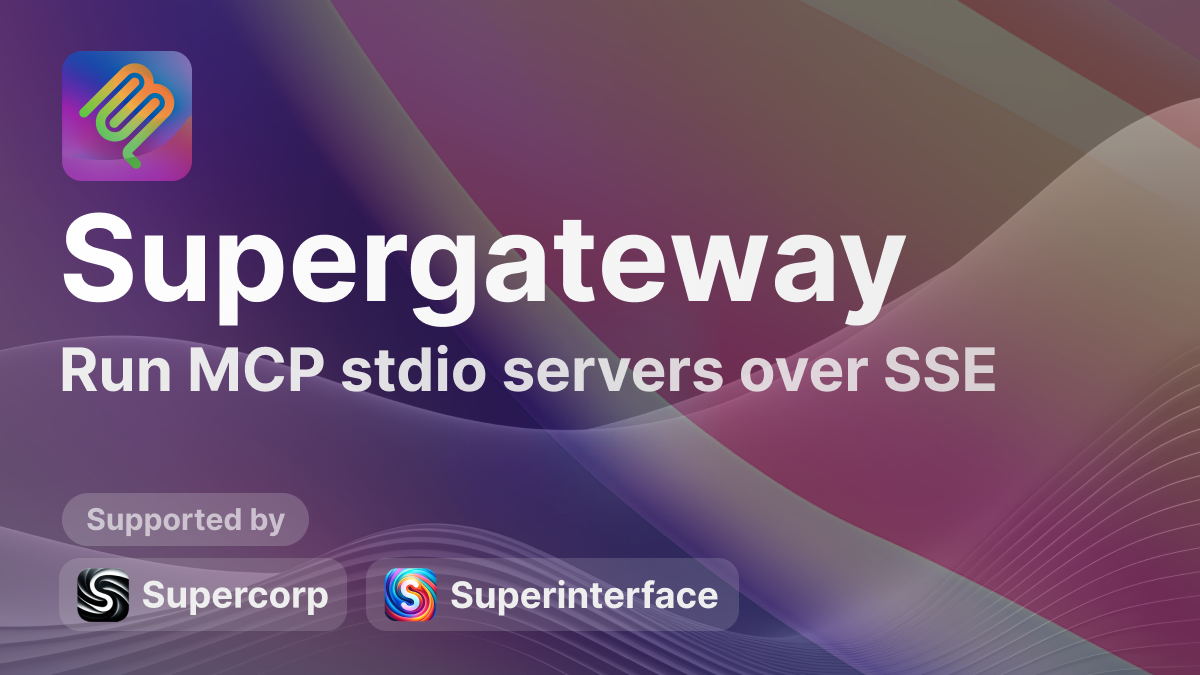Package Exports
This package does not declare an exports field, so the exports above have been automatically detected and optimized by JSPM instead. If any package subpath is missing, it is recommended to post an issue to the original package (@latitude-data/supergateway) to support the "exports" field. If that is not possible, create a JSPM override to customize the exports field for this package.
Readme

Supergateway runs a MCP stdio-based servers over SSE (Server-Sent Events) with one command. This is useful for remote access, debugging, or connecting to SSE-based clients when your MCP server only speaks stdio.
Supported by superinterface.ai, supermachine.ai and supercorp.ai.
Installation & Usage
Run Supergateway via npx:
npx -y supergateway --stdio "uvx mcp-server-git"--port 8000: Port to listen on (default:8000)--stdio "command": Command that runs an MCP server over stdio--baseUrl "http://localhost:8000": Base URL for SSE clients (stdio to SSE mode; optional)--ssePath "/sse": Path for SSE subscriptions (stdio to SSE mode; default:/sse)--messagePath "/message": Path for SSE messages (stdio to SSE mode; default:/message)--sse "https://mcp-server.supermachine.app": SSE URL to connect to
Once started on SSE:
- SSE endpoint:
GET http://localhost:8000/sse - POST messages:
POST http://localhost:8000/message
SSE to Stdio Mode
Supergateway also supports running in SSE to Stdio mode. Instead of providing a --stdio command, specify the --sse flag with an SSE URL. In this mode, Supergateway connects to the remote SSE server and exposes a local stdio interface for downstream clients.
Example:
npx -y supergateway --sse "https://mcp-server-example.supermachine.app"Example with MCP Inspector
- Run Supergateway:
npx -y supergateway --port 8000 \ --stdio "npx -y @modelcontextprotocol/server-filesystem /Users/MyName/Desktop"
- Use MCP Inspector:You can then read resources, list tools, or run other MCP actions through Supergateway.
npx @modelcontextprotocol/inspector --uri http://localhost:8000/sse
Using with ngrok
You can use ngrok to share your local MCP server with remote clients:
npx -y supergateway --port 8000 \
--stdio "npx -y @modelcontextprotocol/server-filesystem ."
# In another terminal:
ngrok http 8000ngrok then provides a public URL.
Why MCP?
Model Context Protocol standardizes how AI tools exchange data. If your MCP server only speaks stdio, Supergateway exposes an SSE-based interface so remote clients (and tools like MCP Inspector) can connect without extra server changes.
Advanced Configuration
Supergateway is designed with modularity in mind:
- It automatically derives the JSON‑RPC version from incoming requests, ensuring future compatibility.
- Package information (name and version) is retransmitted where possible.
- Stdio-to-SSE mode uses standard logs and SSE-to-Stdio mode logs via stderr (as otherwise it would prevent stdio functionality).
Contributing
Issues and PRs are welcome. Please open one if you have ideas or encounter any problems.